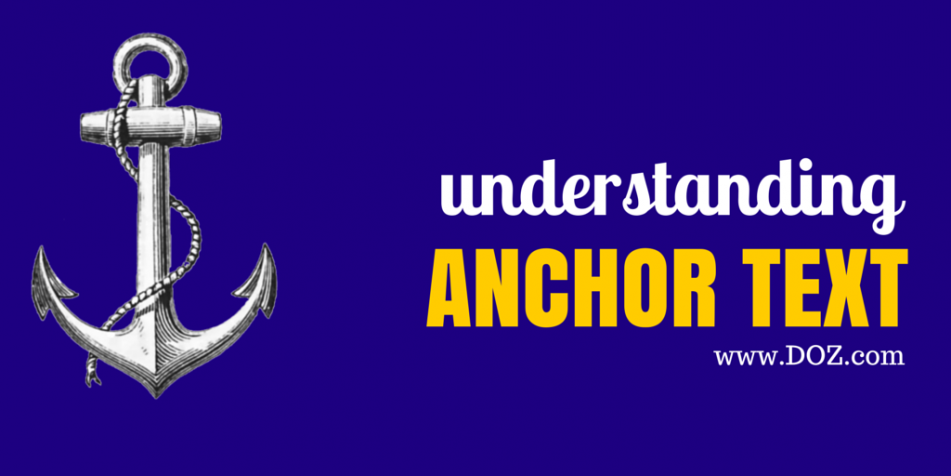Sometimes the most simple things can have a significant effect on your SEO. Things like anchor text.
Anchor text is a basic element in your onsite and offsite SEO. In a world where the web is connected by hyperlinks (usually just referred to as ‘links’) the words that sit highlighted by those links is known as anchor text.
But what different types of anchor text exist? And which sorts of anchor text should you use regularly? What counts as best practice when it comes to linking within your own site and to the sites of others?
This post sets out to take you through the very basics of anchor text, to help you understand why it is important for SEO, and explain the most effective ways to use anchor text on your site for readability and to boost your SEO.
What is anchor text?
Imagine you want to link to the New York Times in a blog post. You type a paragraph, find the text in that paragraph that you want to use as the basis for your link, highlight that text, and add the link. That highlighted text is probably blue now (something like New York Times) and that blue text is your anchor text.
The choice of words that are highlighted and then linked to the NYT is, of course, your choice to make. The Times cannot force you to use their name, or even to shorten it to something like NYT, The Times, or The Grey Lady, as the paper is sometimes known. You can even refer to the newspaper of record as that east coast rag – nope, they cannot stop you – but it probably won’t endear you to the readership. It will stand as the anchor text in your post, however, and that’s what this post is about.
What different types of anchor text are there?
In one sense all anchor text is the same: it’s simply the text that you click to follow a link. But that’s something akin to saying that all cars are the same because they have four wheels – technically you’d be right, but you’d have to admit that there is a bit of a difference between a Mini and a Porsche, right? It’s the same with anchor text. In fact, we can identify five different types of anchor text.
First is exact match anchor text. This is when the anchor text is directly related to the name, theme, and topic of the link. A good example would be linking to a Wikipedia page (say http://en.wikipedia.org/wiki/Romania) with the anchor text ‘Romania’.
Second is branded anchor text. Quite simply, this is when the anchor text is the same as a brand or organization, and the link is directly to that brand or organization. An example might be linking the anchor text ‘IKEA’ to http://ikea.com. This is valuable for brands and helps enormously with SEO.
Third is a naked link. Don’t panic: naked links are definitely SFW. A naked link is simply when the anchor text is the same as the site address it is linking to. For example, if we were linking the DOZ homepage using a naked link we would simply type ‘https://www.doz.com’ and link that, er, link to https://www.doz.com.
Fourth is generic anchor text. This is where the anchor text doesn’t specifically relate to the page being linked to. Usually it asks the reader to take an action such as ‘Click here’ or ‘Read more’ and is not at all useful for SEO purposes.
Fifth and finally, there is the anchor text associated with images. As an image on a website is a visual element and there is no anchor text, per se, to speak of, search engines instead look for the alt-text. When an image is linked to a page elsewhere, the alt-text is considered the anchor text for the image in question.
What is anchor text best practice?
There are three things you can keep in mind when working with anchor text and deciding how to connect pages on your own site or elsewhere to your content.
1. Use Relevant Keywords
When choosing your anchor text you should aim to link to relevant keywords. While this is good practice for all links you make, it is particularly important when linking to your own content as search engines will rank your page for those keywords in part thanks to your anchor text.
2. Avoid Generic Anchor Text
Readers need cues about where you are sending them. Anchor text can tell a reader that you are sending them to IKEA, Romania, DOZ, or elsewhere. but ‘click here’ or ‘read more’ doesn’t necessarily give a reader a compelling reason to click. If you are trying to add value, avoid the generic anchor text.
3. Keep It Short
Anchor text should be a word, a few words maybe, but not more. Don’t link a paragraph, and avoid linking an entire sentence when you can link to specific words in that sentence instead. If you are linking to IKEA, for example, use the anchor text ‘IKEA’ rather than ‘Buy this table today at your closest IKEA’.
Want an easy to follow guide on anchor text to view online or download for later? Check out our SlideShare presentation Understanding Anchor Text.




13 Comments
122249 369314Basically a smiling visitor here to share the love (:, btw excellent pattern . 483796
Sutter Health
281057 701820Official NFL jerseys, NHL jerseys, Pro and replica jerseys customized with Any Name / Number in Pro-Stitched Tackle Twill. All NHL teams, full range of styles and apparel. Signed NFL NHL player jerseys and custom team hockey and football uniforms 464109
Hi there! I could have sworn I’ve visited this web site before but after browsing through a few of
the articles I realized it’s new to me. Anyways, I’m certainly pleased I discovered it and I’ll be book-marking it and checking back regularly!
361995 735907This will be a fantastic internet web site, will you be involved in doing an interview regarding how you developed it? If so e-mail me! 726517
smooth jazz
Some really excellent info I look forward to the continuation.
But wanna say that this really is quite helpful Thanks for taking your time to write this.
A number of them are rife with spelling problems and I find it very bothersome to tell the truth on the other hand I will surely come again again.
I m often to blogging and i really appreciate your content. The article has actually peaks my interest.
Thanks , I have just been searching for info approximately this subject for
ages and yours is the best I’ve discovered so far.
However, what about the bottom line? Are you positive about the
supply?
648638 524387I like the valuable information you offer inside your articles. Ill bookmark your blog and check again here regularly. Im quite certain Ill learn a lot of new stuff correct here! Good luck for the next! 301598
844343 253431That is some inspirational stuff. Never knew that opinions could be this varied. Be certain to maintain writing. 757367